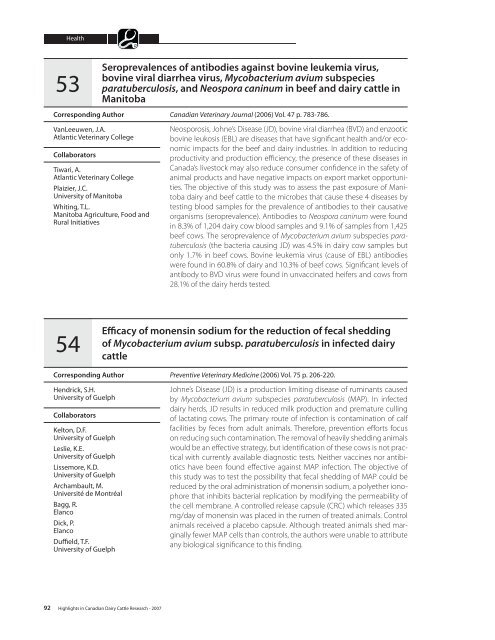A52-75-2007E.pdf - AgroMedia International Inc
A52-75-2007E.pdf - AgroMedia International Inc
A52-75-2007E.pdf - AgroMedia International Inc
Create successful ePaper yourself
Turn your PDF publications into a flip-book with our unique Google optimized e-Paper software.
Health53Seroprevalences of antibodies against bovine leukemia virus,bovine viral diarrhea virus, Mycobacterium avium subspeciesparatuberculosis, and Neospora caninum in beef and dairy cattle inManitobaCorresponding AuthorVanLeeuwen, J.A.Atlantic Veterinary CollegeCollaboratorsTiwari, A.Atlantic Veterinary CollegePlaizier, J.C.University of ManitobaWhiting, T.L.Manitoba Agriculture, Food andRural InitiativesCanadian Veterinary Journal (2006) Vol. 47 p. 783-786.Neosporosis, Johne’s Disease (JD), bovine viral diarrhea (BVD) and enzooticbovine leukosis (EBL) are diseases that have significant health and/or economicimpacts for the beef and dairy industries. In addition to reducingproductivity and production efficiency, the presence of these diseases inCanada’s livestock may also reduce consumer confidence in the safety ofanimal products and have negative impacts on export market opportunities.The objective of this study was to assess the past exposure of Manitobadairy and beef cattle to the microbes that cause these 4 diseases bytesting blood samples for the prevalence of antibodies to their causativeorganisms (seroprevalence). Antibodies to Neospora caninum were foundin 8.3% of 1,204 dairy cow blood samples and 9.1% of samples from 1,425beef cows. The seroprevalence of Mycobacterium avium subspecies paratuberculosis(the bacteria causing JD) was 4.5% in dairy cow samples butonly 1.7% in beef cows. Bovine leukemia virus (cause of EBL) antibodieswere found in 60.8% of dairy and 10.3% of beef cows. Significant levels ofantibody to BVD virus were found in unvaccinated heifers and cows from28.1% of the dairy herds tested.54Efficacy of monensin sodium for the reduction of fecal sheddingof Mycobacterium avium subsp. paratuberculosis in infected dairycattleCorresponding AuthorHendrick, S.H.University of GuelphCollaboratorsKelton, D.F.University of GuelphLeslie, K.E.University of GuelphLissemore, K.D.University of GuelphArchambault, M.Université de MontréalBagg, R.ElancoDick, P.ElancoDuffield, T.F.University of GuelphPreventive Veterinary Medicine (2006) Vol. <strong>75</strong> p. 206-220.Johne’s Disease (JD) is a production limiting disease of ruminants causedby Mycobacterium avium subspecies paratuberculosis (MAP). In infecteddairy herds, JD results in reduced milk production and premature cullingof lactating cows. The primary route of infection is contamination of calffacilities by feces from adult animals. Therefore, prevention efforts focuson reducing such contamination. The removal of heavily shedding animalswould be an effective strategy, but identification of these cows is not practicalwith currently available diagnostic tests. Neither vaccines nor antibioticshave been found effective against MAP infection. The objective ofthis study was to test the possibility that fecal shedding of MAP could bereduced by the oral administration of monensin sodium, a polyether ionophorethat inhibits bacterial replication by modifying the permeability ofthe cell membrane. A controlled release capsule (CRC) which releases 335mg/day of monensin was placed in the rumen of treated animals. Controlanimals received a placebo capsule. Although treated animals shed marginallyfewer MAP cells than controls, the authors were unable to attributeany biological significance to this finding.92 Highlights in Canadian Dairy Cattle Research - 2007





